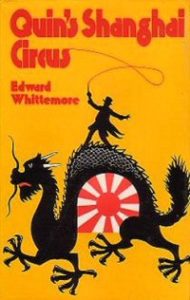 By EDWARD WHITTEMORE (Henry Holt; 1974)
By EDWARD WHITTEMORE (Henry Holt; 1974)
This novel, the first by ex-CIA operative Edward Whittemore, is ostensibly about a man attempting to find the whereabouts of his parents in WWII-era Shanghai, but its true concerns are far more dense and kaleidoscopic. It’s essentially a portrait–a highly skewed one—of a very specific place and time, related through the absurd and frequently surreal experiences of numerous quirky characters.
Whittemore structures the book in a manner that admittedly takes some getting used to: as a series of mini-biographies whose characters and events frequently overlap. There’s Geraty, a massively fat American-born pervert who arrives in New York with a massive collection of Japanese pornography; Father Lamereaux, an alcoholic priest who seems to know everything that happens to everyone in this novel; Big Gobi, an ex-soldier who’s unhealthily obsessed with oysters; Adzhar, an insatiable Russian horndog; and Mama, a brothel owner privy to all manner of espionage through her military general husband.
Other characters include a morose circus owner, a chronically masturbating corporal and a necrophiliac policeman. The latter provides many of the book’s more gruesome set-pieces—speaking of which, there’s a VERY graphically rendered detailing of the atrocities that accompanied the rape of Nanking, and we mustn’t ignore the book’s most outrageous passage, involving a Shanghai circus in which fear, disillusionment and thwarted desire are manifested in a torrent of grand guignol nastiness that includes spiked poles, sawed-through stilts and hungry animals loosed upon the crowd.
Repeated motifs, including oysters (a substance “encapsuled and complete” that resembles “the gray jelly of the brain”) and a gold cross that passes from one character to another, further constitute this novel’s unique tapestry. As the espionage thriller it’s been sold as QUIN’S SHANGHAI CIRCUS is a fail (outside the globe-trotting multi-character scope, it’s difficult to discern where the author’s CIA experience might factor in), but as experimental adult-oriented fiction it ranks pretty high, with a format, style and attitude all its own.
